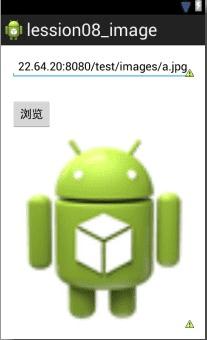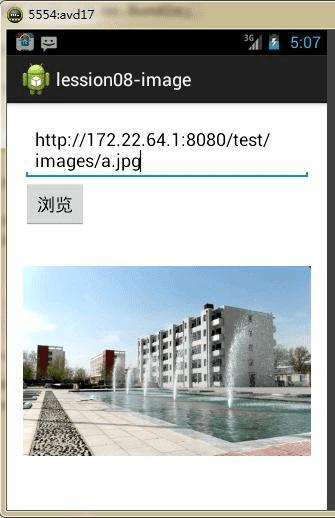Android互联网访问图片并在客户端显示的方法
本文实例讲述了Android互联网访问图片并在客户端显示的方法。分享给大家供大家参考,具体如下:
1、布局界面
<RelativeLayout xmlns:android="http://schemas.android.com/apk/res/android" xmlns:tools="http://schemas.android.com/tools" android:layout_width="match_parent" android:layout_height="match_parent" android:paddingBottom="@dimen/activity_vertical_margin" android:paddingLeft="@dimen/activity_horizontal_margin" android:paddingRight="@dimen/activity_horizontal_margin" android:paddingTop="@dimen/activity_vertical_margin" tools:context=".MainActivity" > <EditText android:id="@+id/url_text" android:layout_width="wrap_content" android:layout_height="wrap_content" android:layout_alignParentLeft="true" android:layout_alignParentRight="true" android:layout_alignParentTop="true" android:ems="10" android:inputType="textPostalAddress" android:text="@string/url_text" > <requestFocus /> </EditText> <Button android:id="@+id/btn_text" android:layout_width="wrap_content" android:layout_height="wrap_content" android:layout_alignLeft="@+id/url_text" android:layout_below="@+id/url_text" android:layout_marginTop="32dp" android:onClick="sendHttp" android:text="@string/btn_text" /> <ImageView android:id="@+id/iv_ie" android:layout_width="wrap_content" android:layout_height="wrap_content" android:layout_alignParentBottom="true" android:layout_alignParentLeft="true" android:layout_alignRight="@+id/url_text" android:layout_below="@+id/btn_text" android:src="@drawable/ic_launcher" /> </RelativeLayout>

2、封转的一些类
URL的封装:
package com.example.lession08_code.utis;
import java.io.InputStream;
import java.net.HttpURLConnection;
import java.net.URL;
import android.graphics.Bitmap;
import android.graphics.BitmapFactory;
public class HttpUtils {
public static String sendGet(String path){
String content=null;
try{
//设置访问的url
URL url=new URL(path);
//打开请求
HttpURLConnection httpURLConnection=(HttpURLConnection) url.openConnection();
//设置请求的信息
httpURLConnection.setRequestMethod("GET");
//设置请求是否超时
httpURLConnection.setConnectTimeout(5000);
//判断服务器是否响应成功
if(httpURLConnection.getResponseCode()==200){
//获取响应的输入流对象
InputStream is=httpURLConnection.getInputStream();
byte data[]=StreamTools.isTodata(is);
//把转换成字符串
content=new String(data);
//内容编码方式
if(content.contains("gb2312")){
content=new String(data,"gb2312");
}
}
//断开连接
httpURLConnection.disconnect();
}catch(Exception e){
e.printStackTrace();
}
return content;
}
public static Bitmap sendGets(String path){
Bitmap bitmap=null;
try{
//设置访问的url
URL url=new URL(path);
//打开请求
HttpURLConnection httpURLConnection=(HttpURLConnection) url.openConnection();
//设置请求的信息
httpURLConnection.setRequestMethod("GET");
//设置请求是否超时
httpURLConnection.setConnectTimeout(5000);
//判断服务器是否响应成功
if(httpURLConnection.getResponseCode()==200){
//获取响应的输入流对象
InputStream is=httpURLConnection.getInputStream();
//直接把is的流转换成Bitmap对象
bitmap=BitmapFactory.decodeStream(is);
}
//断开连接
httpURLConnection.disconnect();
}catch(Exception e){
e.printStackTrace();
}
return bitmap;
}
}
判断网络是否连接的封装类
package com.example.lession08_code.utis;
import android.app.AlertDialog;
import android.content.ComponentName;
import android.content.Context;
import android.content.DialogInterface;
import android.content.Intent;
import android.net.ConnectivityManager;
import android.net.NetworkInfo;
import android.widget.Toast;
public class NetWorkUtils {
private Context context;
// 网路链接管理对象
public ConnectivityManager connectivityManager;
public NetWorkUtils(Context context) {
this.context = context;
// 获取网络链接的对象
connectivityManager = (ConnectivityManager) context
.getSystemService(Context.CONNECTIVITY_SERVICE);
}
public boolean setActiveNetWork() {
boolean flag=false;
// 获取可用的网络链接对象
NetworkInfo networkInfo = connectivityManager.getActiveNetworkInfo();
if (networkInfo == null) {
new AlertDialog.Builder(context)
.setTitle("网络不可用")
.setMessage("可以设置网络?")
.setPositiveButton("确认",
new DialogInterface.OnClickListener() {
@Override
public void onClick(DialogInterface dialog,
int which) {
Toast.makeText(context, "点击确认",
Toast.LENGTH_LONG).show();
// 声明意图
Intent intent = new Intent();
intent.setAction(Intent.ACTION_MAIN);
intent.addCategory("android.intent.category.LAUNCHER");
intent.setComponent(new ComponentName(
"com.android.settings",
"com.android.settings.Settings"));
intent.setFlags(0x10200000);
// 执行意图
context.startActivity(intent);
}
})
.setNegativeButton("取消",
new DialogInterface.OnClickListener() {
@Override
public void onClick(DialogInterface dialog,
int which) {
}
}).show();// 必须.show();
}
if(networkInfo!=null){
flag=true;
}
return flag;
}
}
输出流的封装类
package com.example.lession08_code.utis;
import java.io.ByteArrayOutputStream;
import java.io.IOException;
import java.io.InputStream;
public class StreamTools {
public static byte[] isTodata(InputStream is) throws IOException{
//字节输出流
ByteArrayOutputStream bops=new ByteArrayOutputStream();
//读取数据的缓冲区
byte buffer[]=new byte[1024];
//读取记录的长度
int len=0;
while((len=is.read(buffer))!=-1){
bops.write(buffer, 0, len);
}
//把读取的内容转换成byte数组
byte data[]=bops.toByteArray();
return data;
}
}
注意:在这里还需要加权限问题
<uses-permission android:name="android.permission.ACCESS_NETWORK_STATE"/> <uses-permission android:name="android.permission.INTERNET"/>

希望本文所述对大家Android程序设计有所帮助。
若文章对您有帮助,帮忙点个赞!

(微信扫码即可登录,无需注册)